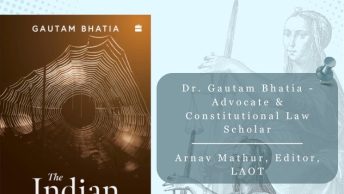In another manifestation of the Supreme Court’s activist avatar as well as the trend of poorly written judgments, Justice Pasayat writing for the court in In re Destruction of Public and Private Properties v. State of Andhra Pradesh and Others, has issued a series of guidelines to “fill the [alleged] vacuum in the law” regarding destruction of public and private property. Taking a serious note of the large scale destruction of public and private properties in the course of agitations, bandhs, hartals etc., the court initiated suo motu proceedings in May 2007 and appointed two committees, one headed by retd. Justice KT Thomas and the other by Mr. Fali Nariman to submit recommendations for supplementing the law relating to this issue as contained in the Prevention of Destruction of the Public Property Act,1984 (“PDPP” or “the Act”). The Act criminalises the destruction of public property and provides for the imposition of sentences upto a period of five years for such destruction. Citing various precedents including Vishaka v. State of Rajasthan, AIR 1997 SC 3011 for the proposition that the “judiciary [under Article 32] not only can but [apparently] must in the exercise of its constitutional obligations step in” to fill a perceived legal vacuum, the court in its decision dated April 16, 2009, issued a series of guidelines seeking to (i) change the evidentiary requirements for proving the commission of an offence under the PDPP Act, (ii) empower the police to enable them to better perform their statutory duties under the Police Act, 1861 and the Criminal Procedure Code, 1973 and (iii) to create a special purpose vehicle for assessing and awarding damages in riot cases. I briefly summarise below the guidelines pertaining to the first two issues but do not discuss them in any further detail in this post.
1. The PDPP Act must be so amended as to incorporate a rebuttable presumption of guilt after the prosecution has established two facts, namely, (i) that those accused were the leaders or office bearers of the organisation which called for the direct actions and (ii) that public property has been damaged in or during or in the aftermath of such direct actions.
2. The Act must contain a provision that makes the leaders of the organisation, which calls for the direct action, guilty of abetment of the offence. A more detailed discussion of the Supreme Court’s judgment on this point can be found here.
3. The Act must empower police officers to maintain a panel of local video operators in order to collect videographic evidence of the damage to public property, which evidence would be admissible in court pursuant to amendments to the Evidence Act, 1872.
The remainder of this post will focus on the court’s directions with respect to awarding damages in tort for destruction of public and private property. Justice Pasayat begins by stating the classic distinction between criminal and tort law, the purpose of the former being to protect the public interest and punish wrongdoers, while that of the latter being to vindicate the rights of the individual and compensate the victim for loss, injury or damage suffered by him. He then swiftly moves on to recognize the awarding of exemplary damages in tort law, whose evident purpose is to deter certain kinds of actions as illustrating the fact that the distinction between tort and criminal law is not as rigid and immutable as appears on first glance. Adopting the Nariman Committee’s recommendations that in cases of destruction of property due to rioting etc. while compensatory damages must be the rule, the court held that punitive damages could be awarded to punish instances of vandalism and rioting to act as a future deterrent. The court went on to issue detailed guidelines regarding the initiation of judicial proceedings in such cases, the imputation of liability to private parties and its apportionment between parties as well as the procedure for assessment and awarding of damages in such cases.
1. Wherever a mass destruction to property takes place due to protests etc., the High Court or, where more than one state is involved, the Supreme Court can initiate suo motu proceedings to investigate the damage caused and to award compensation
2. In each case, the court shall appoint a sitting or retired High Court judge or a sitting or retired District judge as a Claims Commissioner to estimate the damages and investigate liability.
3. The Claims Commissioner may seek court instructions to summon video or other recordings from private and public sources to pinpoint thedamage and establish nexus with the perpetrators of the damage.
4. The principles of absolute liability shall apply once the nexus with the event that precipitated the damage is established. The court will apportion liability between the actual perpetrators of the crime as well as organisers of the event giving rise to liability.
5. Exemplary damages may be awarded to an extent not greater than twice the amount of the damages liable to be paid.
6. Damages shall be assessed for causing destruction to public and private property as well as for causing injury or death to a person or persons and finally for costs of preventive actions by the police and the other authorities.
This blog has discussed the merits of civil vs. criminal liability for perpetrators of violence resulting in loss of life and destruction of property here and here. I believe and have previously written about the need for both civil and criminal liability for such actions. As Tarunabh succinctly puts it here, those who use violence for furthering their ends in defiance of constitutional values must pay up.
However, the court in its decision not only overreaches its authority in its so called attempt to supplement existing law, it also fails to provide any basis for its authority to issue directions making private persons liable for compensatory and punitive damages for loss of lives and destruction of private property. In providing a mechanism for awarding damages for destruction of both public and private property, the court goes beyond the provisions of the PDPP Act, which imposes criminal liability only for the destruction of public property, defined as property which is owned by, or in possession of or under the control of the government of India. Therefore, insofar as the court’s directions seek to make private persons/organizations liable for destruction of private property in cases of bandhs/riots, it cannot automatically be assumed that the authority to issue such directions emanates from Article 32 of the Constitution.
Of course, various High Courts in the past have made governments liable for tort damages in riot cases. In R. Gandhi v. Union of India (1989), the Madras High Court, in M/s Inderpuri General Stores v. Union of India (1992), the Jammu and Kashmir High Court and in Manjit Singh Sawhney v. Union of India (2005), the Delhi High Court ordered respective state and union governments to pay compensation to the victims of the anti-Sikh riots. The state’s liability was grounded on the inaction by state offcials in protecting life and property. These decisions are justified under the constitutional torts jurisprudence of the court, which provides for the use of a tort law remedy to make governments liable for violations of fundamental rights in constitutional law.
However, the current decision makes individual perpetrators tortiously liable under the public law mechanism of a writ remedy that is available to enforce fundamental rights, most of which are available only against the state. Ordinarily, an individual can bring a private law tort suit against the perpetrators of the riots but then he would be subject to the rules of evidence and civil procedure applicable under an ordinary civil suit. By the mechanism outlined by the court individuals can essentially bring tort claims for damages by filing writ petitions against private parties responsible for calling the hartal/bandh during which the destruction of private property took place. The availability of such a remedy is premised on the existence of a norm of horizontal application of rights between private parties without any discussion as to whether there is textual support for such a norm. While the court’s intention in introducing a mechanism that makes those who resort to violence accountable for their actions is laudable, the method by which the court goes about providing for the same is problematic. The court’s selective and ad hoc approach to horizontal application of fundamental rights has led to inconsistent interpretations of constitutional rights norms resulting in a muddled and messy fundamental rights jurisprudence. Thus, after this decision, while private parties may be constitutionally liable to individuals for violence to life and property during riots and bandhs, they may continue to discriminate on grounds of caste and religion in selling them or renting out property. The need of the hour is for Parliament to enact a statute governing civil liability in cases of destruction of public and private property to substitute ad hoc judicial lawmaking in this area.






namita, thanks very much for this careful analysis of the judgment. if i read you correctly, there are four main issues with the judgment:
1. Recommendations to Parliament on amending the PDPP Act. This bit, if it is activism at all, is only recommendatory. Presumably, the Court’s opinions on how the Act should be amended will have no effect on law.
2. Development of tort law to make organisers and party leaders vicariously liable. Tort law is judicial terittory in traditional common law, and if one must find a constitutional basis for the judicial power to develop tort law, it would perhaps be article 372. i don’t think this is an instance of judicial activism either. of course, this is judicial law-making– but a role accepted throughout the common law world as within judicial propriety.
3. The special implementation vehicle by allowing direct involvement of constitutional courts rather than civil courts. This, as you rightly point out, is the stickiest issue. Is this special vehicle created merely as an advancement of tort law (in which case we need reasons for why some torts can go to constitutional courts, and others can’t). or is this indeed towards the enforcement of horizontal fundamental rights? to be fair, vishaka is indeed a good authority for enforcement of horizontal fundamental rights, but as you rightly point out, the court’s approach towards horizontality has been ill-defended and selective. personally, i think, the constitution has a number of resources that can lead to horizontality. some provisions like article 17 are not addresssed to the state alone. we could alsoo make use of directive principles and fundamental duties to reach horizontality. but you are right, the judgment makes no attempt to argue this out (but then, it just needed to show vishaka). but can one make use of judicial role in tort law to justify even this special vehicle, without alluding to constittuional justification?
of course, there is also an argument that constitutional values can legitimately apply horizontally in the development of the common law. the argument goes that even if article 15 cannot apply directly between parties, the courts should develop the tort of discrimination, since constitution pervades all laws. see, generally, Nicholas Bamforth, 'The True "Horizontal Effect" Of the Human Rights Act 1998' (2001) 117 Law Quarterly Review 34; Nicholas Bamforth, 'A Constitutional Basis for Anti-Discrimination Protection?' (2003) 119 Law Quarterly Review 215; and Bamforth, M Malik and C O'Cinneide, Discrimination Law: Theory and Context (Text and Materials) (Sweet & Maxwell, London 2008) 9.
Dear Tarunabh,
Thanks for your comments. Please see my response/thoughts on the points that you have raised below.
1. The recommendations of both the Thomas and Nariman committees were accepted by the court and guidelines were issued to effectuate them. In paragraph 4 of the judgment, after discussing the Thomas committee's recommendations, Justice Pasayat states, "The recommendations according to us are wholesome and need to be accepted. To effectuate the modalities for preventive action and adding teeth to enquiry/investigation following guidelines are to be observed." He then proceeds to list the guidelines.
Justice Pasayat then goes on to discuss the Nariman committee's recommendations on assessment and awarding of civil damages as well as surveys the law on tort liability in England and Australia. In light of this survey and previous precedents of the Supreme Court, Justice Pasayat decides to adopt the Nariman committee's recommendations and issue guidelines. The court states, "In the absence of legislation the following guidelines are to be adopted to assess damages".
The Court then goes on to discuss various precedents to support its authority to issue guidelines including Vineet Narain, D. K. Basu etc. Therefore, in my reading of the judgment, I understand the court's guidelines regarding suitable amendments to the PDPP Act read with the Police Act, the Criminal Procedure Code and the Evidence Act as not mere recommendations but in the nature of guidelines issued by the court that are binding law under Article 141 of the Constitution of India.
2. The power of courts in common law jurisdictions to develop the common law is well accepted. Therefore, of course the Supreme Court and the High Courts can develop principles of tort liability applicable in ordinary civil cases, or in the context of constitutional torts against the government, or in the case of a constitutional tort claim brought jointly against the government and a private party, e.g, the Uphaar tragedy case. I obviously did not mean to suggest that the court was overstepping its powers if that was all it was trying to do. In fact as you know and as I have stated in my blog post, I am a firm believer in the need for civil liability in the kind of cases that the court was considering and welcome the court's development of the common law in this and previous cases (like the MC Mehta case, where the court laid down the principle of absolute liability). However, there exist different views on whether even judicial lawmaking in this area in the form that it has taken over the years is activist or not.
3. My problem with the court's judgment as you have rightly identified lies with its enunciation of a public law mechanism subject to special rules of evidence gathering through a writ remedy under Article 32, which is essentially available for vindication of fundamental rights. Now, if there is an accepted norm of horizontal application of rights in the Constitution, then there would no problem whatsoever. But unfortunately, there is no such express provision that all rights in Part III apply horizontally. I have argued in my article on “Human Rights accountability of the IMF and the World Bank: A critique of existing mechanisms and articulation of a theory of horizontal accountability”, 12 U.C. Davis J. Int’l L. & Pol’y (2006), that there exists what is understood as both direct and indirect horizontal effect in the Indian Constitution. For the benefit of those who may not be so familiar with these terms, direct horizontal application implies that a bill of rights can be used to ground a substantive right held by one private person against another private person. Indirect application means that a bill of rights might only influence a court’s interpretation and development of the common law in the equivalent situation. The articles that you have cited in your second comment provide arguments in support of indirect horizontal application. However, I also want to highlight there are many provisions in the Constitution that apply directly, e.g. Art 15(2) (right against discrimination in access to places open to the public), Art 17 (prohibition against untouchability), Article 23 (prohibition against forced labour). Therefore, clearly there is ample basis for the court to assert the existence of horizontal application, whether direct or indirect and ground its judgments on that basis. However, the court’s failure to do so enables it to apply rights horizontally when it so pleases and refuse to apply them when it does not. My criticism is directed only against such selective application and involves an appeal to the court to clarify its jurisprudence on this issue. I just want to add a final note that personally, I am increasingly unsure as to whether horizontal application unconditionally furthers the aims of its proponents (including myself), but that is a longer discussion and therefore probably best postponed to a later post.
We certainly must thank the Supreme Court for saying these many things to safeguard public property from vandalism. The true problem, as I think it lies in, is the reluctance of the Hon’ble Supreme Court to enforce its own ‘guidelines’ in highly challenging situations.
The Court insists on transparency and disclosure with respect to antecedents, criminal records, wealth and educational accomplishments of candidates contesting to various polls. Inspired by such acts, when a petitioner moves the Court to insist on the filing of Income Tax Returns by political parties, the Court throws out the petition at the threshold. As disclosed recently by a leading newspaper, leading political parties are believed to have secured more than Rs.1000 Crores as ‘donations’ in the past five years.
The Court has often lamented on the excesses by the Police. A Seven Judge Bench of the Andhra Pradesh High Court that must have been highly motivated to read frequent comments by the Supreme Court in the newspapers on ‘police execess’ sets out to curb such ‘excess’ by instructing the State Police to file a ‘FIR’ against every death noticed under ‘Police custody’. The Supreme Court summarily stays the same on appeal.
Corruption, going by the vast number of Judgments of the Supreme Court is an ‘intolerable evil’. Yet, petitions before the Supreme Court that have challenged the constitutionality of Section 19 of the Prevention of Corruption Act, 1988 do not seem to have progressed that much at all. After all, is it really difficult to appreciate that, corruption by ‘public servants’ is shielded and so aided almost exclusively by Section 19 of PCA, 1988?
There is also much criticism on selective clearances accorded to certain business interests in matters of ‘non forest’ use of ‘forest areas’. After all, the injunction upon ‘non forest use’ of ‘forest areas’, when originally issued by the Supreme Court, was never meant to be relaxed under any circumstance.
One cannot even count the number of times, the Court has uttered the word ‘transparency’ in its Orders and Judgments. Yet when a Citizen just wanted to ask the Supreme Court if the Judges of the High Courts have, consistent with the Supreme Court’s voluntary resolution, disclosed their wealth annually, the Court presents an utterly unfathomable argument in response.
And the recent Orders on whether Strikes amount to ‘Contempt’ of the Court’s prior Orders, though sound, have led to widespread belief in the people that the Court is not willing to ‘walk its talk’ under challenging circumstances.
So, I would think, the Executive, the Legislature or the Parliament are beginning to vastly discount the Orders of the Court and, with utmost respects to the Supreme Court, I must think that the latest Order on ‘safeguarding public property’ will be ‘consigned’ to the huge collection of ‘Orders’ in the Executive’s locker room.